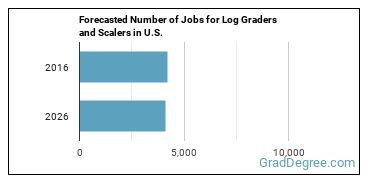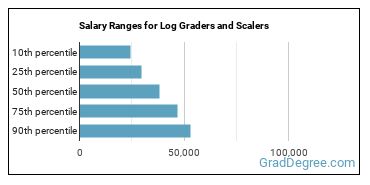Life As a Log Grader or Scaler
Log Grader or Scaler Example Grade logs or estimate the marketable content or value of logs or pulpwood in sorting yards, millpond, log deck, or similar locations. Inspect logs for defects or measure logs to determine volume.
Log Grader or Scaler Responsibilities
- Arrange for hauling of logs to appropriate mill sites.
- Saw felled trees into lengths.
- Drive to sawmills, wharfs, or skids to inspect logs or pulpwood.
- Evaluate log characteristics and determine grades, using established criteria.
- Record data about individual trees or load volumes into tally books or hand-held collection terminals.
- Measure felled logs or loads of pulpwood to calculate volume, weight, dimensions, and marketable value, using measuring devices and conversion tables.
Featured schools near , edit
Qualities of a Log Grader or Scaler
These are the skills Log Graders and Scalers say are the most useful in their careers:
Active Listening: Giving full attention to what other people are saying, taking time to understand the points being made, asking questions as appropriate, and not interrupting at inappropriate times.
Critical Thinking: Using logic and reasoning to identify the strengths and weaknesses of alternative solutions, conclusions or approaches to problems.
Speaking: Talking to others to convey information effectively.
Active Learning: Understanding the implications of new information for both current and future problem-solving and decision-making.
Writing: Communicating effectively in writing as appropriate for the needs of the audience.
Judgment and Decision Making: Considering the relative costs and benefits of potential actions to choose the most appropriate one.
Related Job Titles
- Procurement Forester
- Log Manager
- Log Marker
- Timber Buyer
- Compounding Scaler
Job Outlook for Log Graders and Scalers
In the United States, there were 4,200 jobs for Log Grader or Scaler in 2016. There is little to no growth in job opportunities for Log Grader or Scaler. The BLS estimates 500 yearly job openings in this field.

The states with the most job growth for Log Grader or Scaler are Idaho, Kentucky, and Pennsylvania. Watch out if you plan on working in Vermont, Maine, or North Carolina. These states have the worst job growth for this type of profession.
Do Log Graders and Scalers Make A Lot Of Money?
The typical yearly salary for Log Graders and Scalers is somewhere between $24,610 and $53,230.

Log Graders and Scalers who work in Washington, Oregon, or Wisconsin, make the highest salaries.
Below is a list of the median annual salaries for Log Graders and Scalers in different U.S. states.
| State | Annual Mean Salary |
|---|---|
| Alabama | $39,350 |
| Arkansas | $38,100 |
| California | $40,480 |
| Florida | $30,530 |
| Georgia | $37,410 |
| Idaho | $43,020 |
| Indiana | $46,740 |
| Kentucky | $31,410 |
| Louisiana | $35,900 |
| Maine | $39,170 |
| Michigan | $43,390 |
| Mississippi | $45,040 |
| Missouri | $30,460 |
| Montana | $40,560 |
| New Hampshire | $40,480 |
| New York | $40,060 |
| North Carolina | $41,610 |
| Ohio | $35,750 |
| Oregon | $43,890 |
| Pennsylvania | $36,670 |
| South Carolina | $39,250 |
| Tennessee | $34,330 |
| Texas | $32,640 |
| Vermont | $41,150 |
| Virginia | $35,680 |
| Washington | $47,480 |
| West Virginia | $35,780 |
| Wisconsin | $47,130 |
What Tools do Log Graders and Scalers Use?
Although they’re not necessarily needed for all jobs, the following technologies are used by many Log Graders and Scalers:
- Microsoft Excel
- Microsoft Word
Becoming a Log Grader or Scaler
What education is needed to be a Log Grader or Scaler?

How many years of work experience do I need?

Log Graders and Scalers Sector

Log Graders and Scalers work in the following industries:

References:
More about our data sources and methodologies.
Featured Schools
 Request Info
Request Info
|
Southern New Hampshire University You have goals. Southern New Hampshire University can help you get there. Whether you need a bachelor's degree to get into a career or want a master's degree to move up in your current career, SNHU has an online program for you. Find your degree from over 200 online programs. Learn More > |
